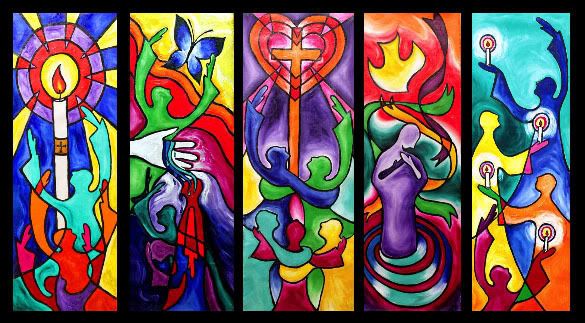by Pastor Laura Gentry
On the October 17th show of the NPR news quiz show “Wait Wait...Don’t Tell Me!” comedian Susie Essman played the game called “Not My Job” in which the contestant is asked three questions about a subject her or she knows nothing about. Since Susie plays a character on the HBO TV show “Curb Your Enthusiasm” who is anything but a saint, they thought it would be funny to ask her questions about famous saints. Indeed, she did, know nothing about them. Still, she managed to make enough educated guesses to win. Now because it is All Saint’s Day, I’m going to ask you those same questions and we’ll see how much you know. If you heard the show, you’ll have to restrain yourself and not give away the answer. (Answers are at the bottom of this blog post)
1. Saint Simeon Stylite of 5th Century Syria was so popular that he drew pilgrims from all over the world. What caused this stir?
a. He ate nothing but tree bark and yet lived.
b. He stood on a pillar outside for 37 years.
c. He could command worms to appear on the surface of the earth whenever he so desired.
2. Saint Joseph of Cupertino, a monk from the 17th Century in Italy. He became famous, too famous in the eyes of the church because he could do what? Was it...
a. Fly
b. Hold his breath for a whole day
c. Talk in the voice of Noah, King David and other Biblical characters
3. Saint Claire of Assisi, famous medieval nun who is known for her good works and her vow of povery. She has a particular role in today’s church, what is it and why did she get it?
a. Because of her famously rapid walks around the monastery, she is the patron saint of NASCAR and other automobile races.
b. Because of regular visions she had on the wall of her room, she is the patron saint of television.
c. As she regularly spoke in tongues she is the patron saint of translators.
When you hear stories about saints like this who could stay on a pillar for years to pray, fly in religious ecstasy and see visions on the wall, it makes us of think of them as being people who are otherworldly, super-hero types. They seem unattainably perfect in the stories we now hear.
For about a thousand years, Jesus and the saints have been portrayed in art with a halo around their head. This is to represent holiness. Christian artists believed that the halo was symbolic of the light of grace bestowed by God. It comes out in an orb around the head like the holy energy of the saintly one. Sometimes, children get confused by this and ask why the people have golden plates stuck on the backs of their heads.
So between the incredible, hard-to-believe stories and the idealized imagery of the saints in art, I don’t think most people associate themselves with saints. Around here we often hear people refer to a scoundrel by saying, “He’s no saint!”
All of these things, I think, contribute to the thinking that saintliness is something earned. We become saints by our exemplary behavior, by our bold faith and our ceaseless obedience to God’s commands, right? Nope. The Bible say we have all sinned and fall short of the glory of God. We can kinda be good but no matter how we hard try, we cannot make ourselves saints.
Does that mean the game is up? Should we throw in the towel and head home because there is no way we are going to attain the status of sainthood? By no means! The good news that we celebrate today is that saint-making is God’s work, not our own.
It all begins in the waters of baptism. Together, the water and God’s word claim us. We are born children of a fallen humanity but in the waters of baptism we are reborn children of God and heirs of eternal life. That’s exciting news because it means that day after day, God gives us grace of righteousness regardless of our worthiness. Martin Luther called this “alien righteousness” because it comes from something outside of ourselves—it is alien. It is certainly not our own righteousness, it is the righteousness that comes from Christ. Paul wrote in II Cor. 1:3; “Blessed be the God and father of our Lord Jesus Christ, the Father of mercies and God of all comfort, who has blessed us in Christ with every spiritual blessing in the heavenly places.”
Through faith in Christ, therefore, Christ’s righteousness becomes OUR righteousness and all that he has becomes ours—yes, Jesus himself becomes ours. And so his saintliness is our saintliness. This alien righteousness is a gift of grace.
This is not the only type of righteousness, however. Luther called the second kind righteousness our “proper righteousness.” By this, he meant that the alien righteousness given to us by Christ doesn’t just sit there. It has power to change us—to bear fruit. And as we read in Galatians 5:22, the fruit of the Spirit is “love, joy, peace, patience, kindness, goodness, faithfulness, gentleness, self-control.” This righteousness enables us, by the power of God, to be transformed into the likeness of Christ. We may never fly like Joseph of Cupertino or get visions on the wall like Claire, and I don't even recommend you try to sit on a pillar for 37 years like Simeon, but we can still become Christ-like. It doesn’t happen all at once, but bit by bit throughout our lives and is finally perfected at the end through death. Yet all the while, we are children of God, and therefore saints. I’m a saint and you’re a saint!
And since there are no halos above your heads like in the paintings, I am going to give you the opportunity to see yourself as the saints you really are, by virtue of your baptism. That’s why I’ve made this “be a saint” painting. Let me show you how it works (puts face through saint painting). Don’t I look saintly?
Now as we sing the hymn of the day, I’ll need some volunteers from our studio audience to come forward and show us their saintliness. And for those of you not brave enough to come now, don’t worry, I will get you later. My plan is to photograph every single one of us in this. After all, it’s All Saints Sunday and we’ve got to celebrate that we are all saints! And in doing so, we celebrate our Savior who has made us his own and infuses us with his righteousness so that we are transformed into the saints God wants us to be. Amen.
See the slideshow of these saints:
Answers to the NPR quiz:
1. Saint Simeon Stylite of 5th Century Syria was so popular that he drew pilgrims from all over the world. What caused this stir?
b. He stood on a pillar outside for 37 years.
2. Saint Joseph of Cupertino, a monk from the 17th Century in Italy. He became famous, too famous in the eyes of the church because he could do what? Was it...
a. Fly
b. He stood on a pillar outside for 37 years.
2. Saint Joseph of Cupertino, a monk from the 17th Century in Italy. He became famous, too famous in the eyes of the church because he could do what? Was it...
a. Fly
3. Saint Claire of Assisi, famous medieval nun who is known for her good works and her vow of povery. She has a particular role in today’s church, what is it and why did she get it?
b. Because of regular visions she had on the wall of her room, she is the patron saint of television.








No comments:
Post a Comment